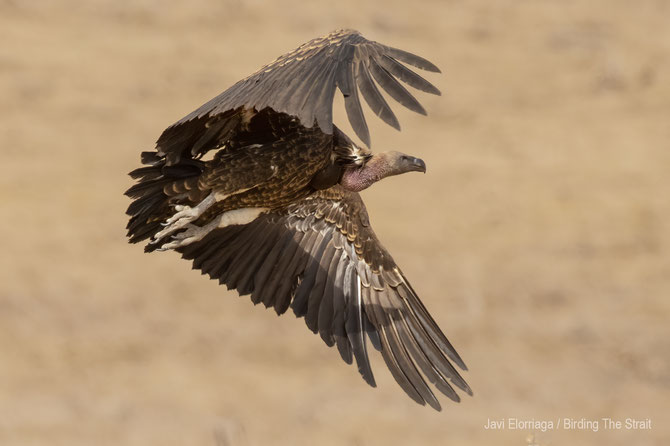
Europe is home to four native vulture species – Bearded, Cinereous, Egyptian and Griffon Vultures. Spain hosts all of the European vulture species and is a vulture stronghold with approximately 90% of the entire European vulture population occurring in the country. In addition to these species, Spain can get two more African vulture species. The Rüppell’s Vulture frequently visits southern Europe, especially Iberia, and has been added to the list of Andalusian birds, making it Europe’s 5th vulture species! Also, another African vulture species, the White-backed vulture, is another rare visitor that has been sighted a handful of times in Iberia. In Tarifa, where thousands of birds congregate to cross the Mediterranean Sea from Europe to Africa in autumn, and vice versa in spring, across the strait of Gibraltar, some might come across all these six vulture species if lucky.
Bearded Vultures in Tarifa
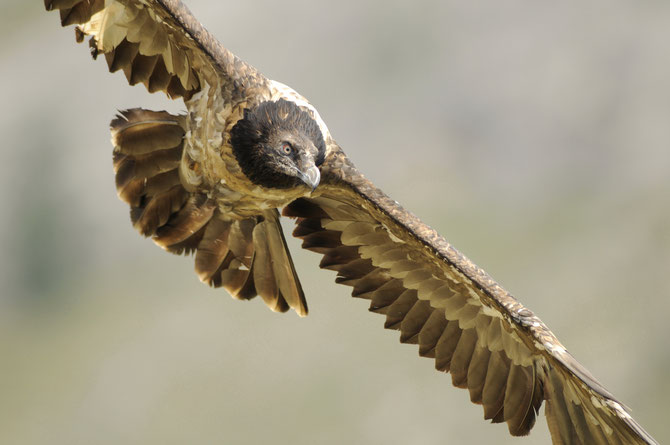
In the past, the Bearded Vulture (Gypaetus barbatus) was found in almost all southern European mountain ranges and the Alps, and it also used to breed in Tarifa. There is an ancient nest of a Bearded Vulture pair in Tarifa, occupied at least until 150 years ago.
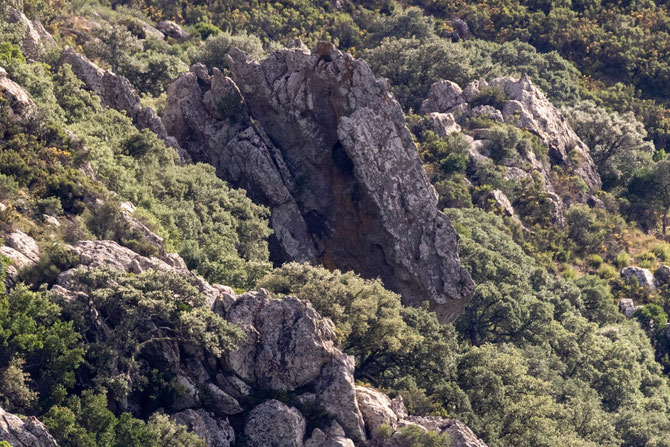
Today, the Bearded Vulture is the rarest vulture species in Europe and Spain, having disappeared from the south of the country over the 20th Century. A reintroduction project based on captive breeding implemented by the Junta de Andalucía alongside the Vulture Conservation Foundation has been releasing birds in the Sierras de Cazorla and Castril since 2006, bringing the species back to Andalusia. When young, Bearded Vultures wander vast distances and explore new areas, and some of the birds released in Andalusia have been all the way down to Tarifa. However, as birds are released with the ‘hacking method’, which is more or less the way they naturally fledge, once they are ready to breed at 8-10 years old, they tend to settle near the release site.
Egyptian Vultures in Tarifa
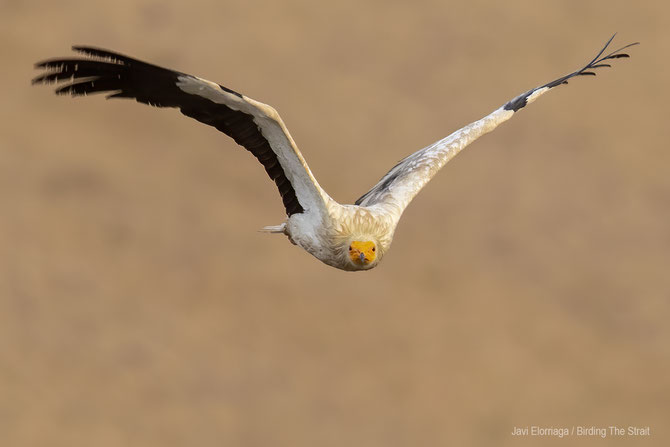
Following the decline of Egyptian Vultures (Neophron percnopterus) across Europe, their population in Iberia has been stable in the past couple of decades thanks to conservation actions. It is Europe’s only long-distance migratory vulture and faces multiple threats along its long flyway. In autumn, the species heads south from its European breeding grounds, with the birds from Portugal-Spain and France usually reaching Tarifa to cross the Strait of Gibraltar, covering the minimum distance possible above open water to arrive at Morocco and continue its journey south to its wintering grounds. During this period, flocks in Tarifa can total over 100 individuals, and birdwatchers can find up to 160 Egyptian Vultures roosting together. Some of these migrants are tagged with GPS transmitters of the VCF, and you can track their movements by visiting the public maps. There are also a few Egyptian Vulture breeding pairs in the region.
Cinereous Vultures in Tarifa
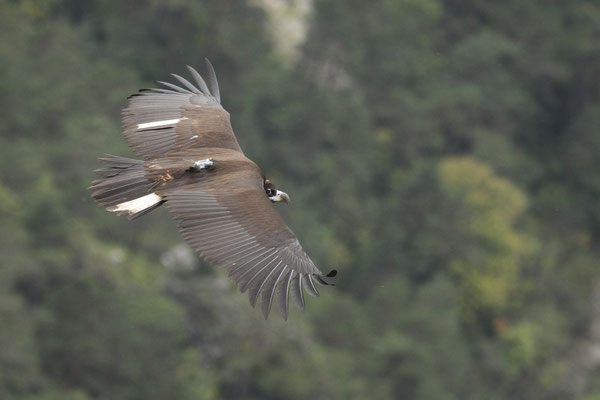
The Cinereous Vulture (Aegypius monachus), which is Europe’s largest vulture species reaching up to 3 metres wingspan, can travel vast distances to explore regions when young. Some individuals even reached Tarifa from afar as we can see from GPS data. Bernardus, a female Cinereous Vulture, hatched in Pairi Daiza Zoo in Belgium in September 2015, was equipped with a GPS transmitter provided by the VCF, before being released in the Gorges du Verdon (France) as part of the Cinereous Vulture reintroduction project there. She has been travelling vastly, and even crossed Spain and reached Tarifa in November 2015 , before returning to France. Generally, Cinereous Vultures are rare in the Gibraltar areas, but are regularly seen in the region, normally as single juveniles on dispersal. A few of them even head further south. They tag along wandering Griffon Vultures that migrate over to Morocco, and a few make it to northwest Africa every year, some descending as far south as Mauritania and The Gambia.
Griffon Vultures in Tarifa

The Griffon Vulture (Gyps fulvus) is the most populous European vulture species, with 35,000 breeding pairs in Europe, of which 30,000 are in Spain. Every year, thousands of Griffon Vultures regularly migrate across the Strait of Gibraltar. Large groups of Griffon Vultures, often in the hundreds, gather in Tarifa just before crossing the Strait to continue their journey to the Sahel during autumn. A certain percentage of the European population winters in West Africa and migrates through Morocco, down in the autumn, and up during spring. Some groups of nonbreeding vultures do stay year-round in the north of Morocco. The Griffon Vulture is Europe’s only native Gyps species, and in the past, when a Gyps species was seen in Europe, it was assumed that it was a Griffon Vulture. In recent years, however, two more Gyps species visiting Iberia have been identified.
Rüppell’s Vultures in Tarifa

The Rüppell’s Vulture (Gyps rueppelli) is an African species whose distribution range is located in the equatorial and eastern areas of the continent. It is Critically Endangered, which is the last category before global extinction, due to the rapid declines of several populations across Africa. Its declining state is mostly due to the successive and frequent mass poisonings in Africa, which are driving several species of African vultures to extinction. Rüppell’s Vultures are becoming alarmingly scarce in Africa but, surprisingly, they are increasingly seen in Europe. This is probably due to increased mixings of individuals of this species with wintering juvenile Griffon Vultures in West Africa that return in Spain during spring. Once they arrive here, there is plenty of food available for them, and some of them stay in Iberia for a while. In 2020, it was confirmed for the first time that two different adult Rüppell’s Vultures have been regarded as showing breeding behaviour in Griffon Vulture colonies in Cádiz and Málaga respectively. In Tarifa, the species is very scarce, but during migrations seasons, it can be often seen, especially when birdwatchers are in search of vultures.
All these five vulture species were seen in Tarifa last week according to Birding the Strait, who provide birding tours in the region. But, if lucky, there is one more species that can be seen in the region.
White-backed Vultures in Tarifa
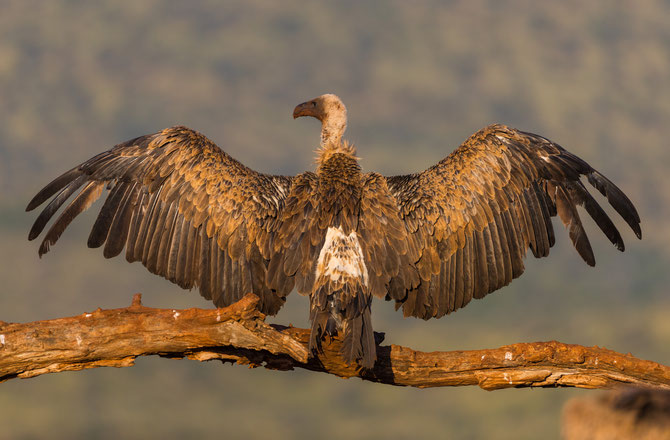
The White-backed Vulture (Gyps africanus) is yet another African and Critically Endangered vulture species, that is distributed in Africa through the Sahel region, from Mauritania east to Sudan and Ethiopia and south to northern and eastern Southern Africa. In Europe, the White-backed Vulture is a rare vagrant, most likely visiting for the same reason as the Rüppell’s Vulture. The species has been recorded at least seven times in the West Palearctic (one in Portugal, two in Morocco and four in Spain), however, other occurrences may have been overlooked.
Have you seen any of these vulture species in Tarifa recently? Tweet us at @4vultures and let us know!
A big thank you goes to Birding the Strait for providing photographs and information about recent sightings.



